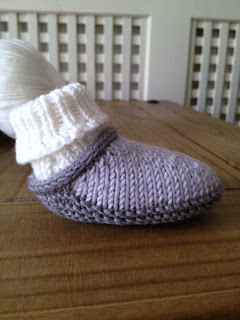There are a good many knitting techniques that tripped me up when I was relatively new to my craft - m1r and m1l, joining to knit in the round, reading a chart correctly, purling through the back loop - to mention just a few. I can remember the utter frustration at my inability to master these seemingly simple instructions - and the resulting disastrous knits! I spent a good deal of time trawling YouTube, various online knitting tutorials and magazines for help with these techniques, and eventually found the solutions. It was a time consuming exercise, but well worth the effort, as these and many other techniques are now reliable tools in my knitting arsenal.
So, I thought it would be useful to share some of this accumulated knowledge as and when these tricky techniques crop up in my knitting projects. Some of these will be very familiar, and it may not be the actual technique that is truly helpful, but just a tip to help you remember how to execute these stitches.
My current project, the
Tivoli cushion is a very simple pattern using a 2 row pattern repeat to create the undulating waves whilst making excellent use of a differing stripe pattern to provide the interest. The pattern uses knitting stitches together and making stitches to create this wave pattern and it is the 'm1' instruction that I'm going to explain further.
To execute the 'm1' as explained in the pattern - 'pick up the bar between the st just worked and next st on left hand needle and knit through the back.' This is technically correct although the detail that ensures making the stitch absolutely perfectly (and without a hole!) is not included. It is difficult to be concise and avoid long-winded explanations in writing knitting patterns - hence the need for so much abbreviation, but in this case there needs to be some addition. I would say - 'pick up the bar between the st just worked and the next st
with your left hand needle from front to back and knit into the back of it.' The stitch just made is actually a 'm1l' which means that you have made a stitch leaning left, and I used this method to increase throughout my Tivoli.
m1l - first, pick up the bar front to back. Next knit into the back of the 'bar'. The completed stitch on the right hand needle.
There is often an instruction to m1l AND m1r, particularly in lace knitting so that the increases lie correctly and mirror each other. For 'm1r' the instruction is almost the same - 'pick up the bar between the st just worked
with your left hand needle from back to front and knit into the front of it.' As you can see from the pictures, the trick to making sure your 'bar' is sitting correctly on the needle is to pick it up either front to back or back to front with your
left needle. This may seem a little awkward to begin with, but it will prove invaluable once you've mastered it.
m1r - pick up the bar back to front. Next knit into the front of the 'bar'. The completed stitch on the right needle.
My final tip for this increase is how to remember which one you are doing! When you're immersed in 300+ stitches of lace knitting, the last thing you want to do is keep looking at your instruction to see which is the method for left or right leaning increases. I heard a mnemonic to help with remembering left and right make 1's on a podcast that I regularly listen to (
Jane and Jen Knit Funny - episode 4), so I can't claim this as my own.
BFF (pick up from the
Back to
Front and knit into the
Front) is also an abbreviation for Best Friend Forever and my best friend was definitely the 'right' choice when we met back in school - therefore BFF=m1r. Corny, but it has embedded itself in my mind so I always know which the 'right' increase is now with just a quick mental reminder!
(posted by Max)












































